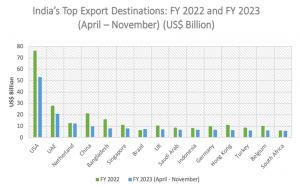
India’s exports are suffering because of a downturn in its largest markets such as the United States and European Union, and trade analysts expect the situation to deteriorate. The micro, small and medium enterprises that account for around 40% of India’s exports will face major challenges because of the global economic slowdown. An analysis by Crisil shows that one in five MSMEs will experience working capital problems as a third of India’s overall exports are directed to the US and EU markets.
One sector heavily reliant on exports is the Indian handicraft industry, which is projected to witness a 6-8% decline in sales this fiscal year, says the Crisil Ratings report. In FY23, the industry experienced a 20% fall in exports, and the anticipated slowdown in discretionary spending in major global markets is expected to further exacerbate the sector’s problems. This will lead to a further decrease in sales, bringing down the estimated value to $3.3 billion this fiscal year. However, the industry’s credit profile remains stable due to minimal capital expenditure (capex) debt.
READ | India’s banks in a bind over tax on outward remittances
MSMEs across different sectors are expected to require higher working capital to maintain smooth operations. However, the current macroeconomic circumstances pose a hurdle. Around a fifth of the micro, small, and medium enterprise (MSME) sector is expected to report an increase in working capital requirements this fiscal year, compared with pre-pandemic levels. Conversely, sectors such as dyes and pigments, construction, gems and jewellery will experience a significant stretch in their working capital days. These sectors are already grappling with high working capital requirements.
Challenging times ahead for MSME sector
Analysts predict that export-oriented MSMEs in Ahmedabad and Surat will witness a substantial increase in their working capital days compared to pre-pandemic levels. Working capital days mean the number of days it takes for a firm to convert its working capital into revenue. Ideally, a company should have fewer working capital days, as a higher number indicates a longer time to convert that working capital into sales and reflects lower efficiency.

The Ahmedabad cluster is expected to experience an increase of 20-25 days in working capital days due to the rise in the working capital requirement of the dyes and pigments sector. Similarly, the Surat cluster is projected to face a 35-day increase, driven by higher working capital requirements in the diamond exports sector. Ahmedabad is a hub for companies dealing in dyes and pigments, pesticides, and pharmaceuticals.
The troubles faced by the above-mentioned industries are exacerbated by an inventory pile-up resulting from dumping by Chinese producers, the recent earthquake in Turkey, and a slowdown in the US. Imports from these three countries together account for 20-25% of the total exports of dyes and pigments, pesticides, and pharmaceuticals.
The gems and jewellery business will also be negatively impacted, primarily due to diamonds. Surat cluster accounts for 90% of diamond exports and diamonds make up over half of the gems and jewellery exports. The demand for diamonds has been dampened in the US, which is the largest export market for India. As a result, working capital days have increased from 140 before the pandemic to over 200 now.
The government has discontinued several policies that previously provided liquidity benefits to MSMEs, such as payments upon achieving small milestones. These schemes were part of the infrastructure push but will not be available in this fiscal year. Consequently, working capital days are expected to increase further.
The estimated debt requirement of MSMEs exceeds Rs 100 lakh crore, with 70% being attributed to working capital. Only a quarter of this amount is sourced through formal channels.
What is causing the economic downturn
The US and EU are grappling with sticky inflation. The EU economy is already under a recession while the US economy is staring at one. Consequently, consumer spending has diminished across major economies. Indian exporters are further affected as these markets, with a combined value of over $500 billion, are predominantly serviced by Chinese exporters, limiting the market space available to them.
In the previous fiscal year, the favourable rupee-dollar exchange rate provided some relief to the industry, mitigating the impact on export sales by approximately 8%. However, exporters see no such respite this year as the exchange rate is expected to remain stable throughout this fiscal year.
Overall, exports are anticipated to remain subdued due to geopolitical circumstances. The ongoing war between Ukraine and Russia has dampened global growth prospects and discretionary spending. Consequently, India’s export sector is likely to suffer, which means exports will not contribute much to economic growth. This will adversely affect India’s GDP growth prospects for the current financial year.
